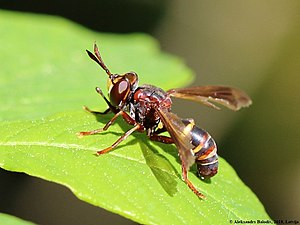Large wasp big head fly
| Large wasp big head fly | ||||||||||||
|---|---|---|---|---|---|---|---|---|---|---|---|---|

Conops vesicularis , female |
||||||||||||
| Systematics | ||||||||||||
|
||||||||||||
| Scientific name | ||||||||||||
| Conops vesicularis | ||||||||||||
| Linnaeus , 1761 |
The great wasp thick head fly ( Conops vesicularis ) is a species from the family of the bladder head flies (Conopidae).
features
The flies reach body lengths between 12 and 18 millimeters. Your face is yellow. A brownish line runs from the base of the red antennae to the sides and a brownish keel to the rear. The rear area of the frons is brownish in color. The brown proboscis (proboscis) is relatively short. The predominantly black mesonotum has red shoulder bumps and is colored red on the lateral edges. The back label and the femora are also colored red. The females are slimmer and much darker than their male counterparts. The abdomen of the males is predominantly yellow in color. The abdomen of the females is predominantly black or dark brown in color and has a prominent yellow band. The female's theca, which protrudes from the fifth sternite , is colored yellow and has a black tip. The wings are shaded along the leading edge.
distribution
The species occurs in Central, South and Southwest Europe. In the north, they occur as far as the British Isles , Sweden and the Baltic States . The species is not considered common.
Way of life
The flies usually appear earlier than other members of the genus Conops . The flight time lasts from April to August. The flies are mostly observed at the edges of the forest or in heathland, where hornets occur. The flies often visit the hawthorn flowers .
The larvae of Conops vesicularis are solitary coinobionte endoparasitoids of hornets and bumblebees. The host species include the hornet ( Vespa crabro ), the hornet species Vespa velutina , which has been introduced into Europe, and the moss bumblebee ( Bombus muscorum ). The female flies match the hornets and bumblebees when they visit the flowers. You place one egg on each host animal's abdomen. The larva hatches, bores into the host's abdomen and goes through three stages there. It feeds on its host's hemolymphs and internal organs. The host dies only shortly before pupation , which takes place within the host. The species Conops vesicularis overwinters as a pupa in the dead host animal. The period between parasitization and death of the host is usually two weeks. Hornet and bumblebee queens are also parasitized by Conops vesicularis . As a result, the hornet or bumblebee colony affected may perish.
Individual evidence
- ↑ a b Conops vesicularis in Fauna Europaea. Retrieved April 27, 2019
- ↑ a b c d e f Eric Darrouzet, Jérémy Gévar, Simon Dupont: A scientific note about a parasitoid that can parasitize the yellow-legged hornet, Vespa velutina nigrithorax , in Europe . In: Apidology . tape 46 , 2015, p. 130–132 , doi : 10.1007 / s13592-014-0297-y (English, researchgate.net [accessed April 27, 2019]).
- ^ Conops vesicularis Linnaeus, 1761 (a thick-headed fly) . www.bioinfo.org.uk. Retrieved April 27, 2019.
Web links
- Identification key for the genus Conops by Mark van Veen
- Conops vesicularis (photos and information) by Steven Falk at www.flickr.com
- Conops vesicularis at www.biolib.cz


